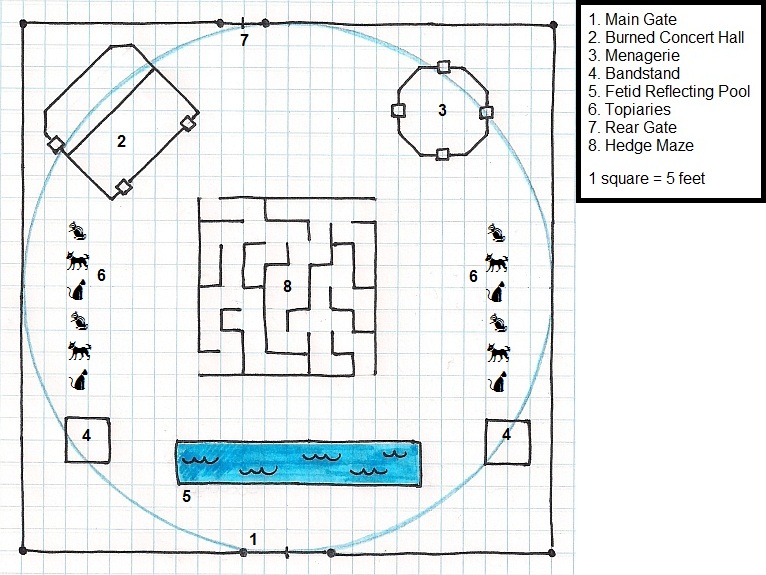The Garden of Unearthly Terrors
 In its full splendor, the pleasure garden was a wonder to visit. Townsfolk once congregated there regularly to enjoy the various entertainments presented in the small concert hall or upon one of the several bandstands. The cleverly trimmed topiaries delighted children, and the centerpiece, a hedge maze, provided fleeting privacy for young lovers to steal a kiss or two. All of this was before the tragic fire in the concert hall that claimed the lives of several townsfolk. One of those killed was a gnome lass betrothed to an emotionally unstable illusionist. The couple had argued earlier that day. The lass went to the pleasure garden alone while her beau sulked at home. When he found out his love had died, the illusionist was inconsolable. He took his own life in the center of the hedge maze a couple of days later. His anguished spirit now jealously guards the decaying pleasure garden.
In its full splendor, the pleasure garden was a wonder to visit. Townsfolk once congregated there regularly to enjoy the various entertainments presented in the small concert hall or upon one of the several bandstands. The cleverly trimmed topiaries delighted children, and the centerpiece, a hedge maze, provided fleeting privacy for young lovers to steal a kiss or two. All of this was before the tragic fire in the concert hall that claimed the lives of several townsfolk. One of those killed was a gnome lass betrothed to an emotionally unstable illusionist. The couple had argued earlier that day. The lass went to the pleasure garden alone while her beau sulked at home. When he found out his love had died, the illusionist was inconsolable. He took his own life in the center of the hedge maze a couple of days later. His anguished spirit now jealously guards the decaying pleasure garden.
Haunted Pleasure Garden
CR 12; XP 19,200
CN persistent haunt (60-foot-radius pleasure garden; on the map, this is everywhere within the blue circle)
Caster Level 12th
Notice Perception DC 25 (shadowy robed figure)
hp 54; Trigger proximity; Reset 1 hour
Effect: The haunt uses material from the Plane of Shadow to shape quasi-real illusions of one or more creatures, objects, or forces. The haunt can mimic any sorcerer or wizard conjuration (summoning) or conjuration (creation) spell of 6th level or lower. These shadow conjurations are three-fifths (60%) as strong as the real things, though creatures who believe the shadow conjurations to be real are affected by them at full strength. Any creature that interacts with the spell can make a Will save (DC 20) to recognize its true nature.
Spells that deal damage have normal effects unless the affected creature succeeds on a Will save. Each disbelieving creature takes three-fifths (60%) damage from the attack. If the disbelieved attack has a special effect other than damage, that effect is 60% likely to occur. Regardless of the result of the save to disbelieve, an affected creature is also allowed any save that the spell being simulated allows, but the save DC always equals 20. In addition, any effect created by haunt’s shadow conjuration allows Spell Resistance, even if the spell it is simulating does not. Shadow objects or substances have normal effects except against those who disbelieve them. Against disbelievers, they are 60% likely to work.
A shadow creature has one-fifth the hit points of a normal creature of its kind (regardless of whether it’s recognized as shadowy). It deals normal damage and has all normal abilities and weaknesses. Against a creature that recognizes it as a shadow creature, however, the shadow creature’s damage is three-fifths (60%) normal, and all special abilities that do not deal lethal damage are 60% likely to work. (Roll for each use and each affected character separately.) Furthermore, the shadow creature’s AC bonuses are just one-fifth as large. A creature that succeeds on its save sees the shadow conjurations as transparent images superimposed on vague, shadowy forms. Objects automatically succeed on their Will saves against the haunt’s shadow conjurations.
Unlike most haunts, this haunt has a sort of innate cunning. It selects effects with intelligence, preferring to divide and conquer groups of trespassers. For example, it might use walls of iron to separate party members from each other, followed by summon monster VI to send shadow creatures after weaker targets while relying on acid fog to slow down and harm others. Of course, the haunt is limited to one effect per round.
Destruction: The bones of the gnome illusionist and his love must be brought to the center of the hedge maze and blessed.
